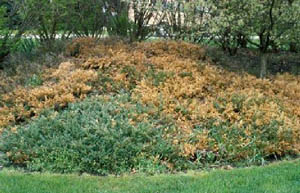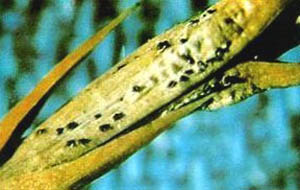Phomopsis Blight of Juniper | |
|---|---|
| May 16, 2006 | |
|
As new growth on junipers appears, so will this juniper tip blight. Phomopsis blight, or juniper tip blight, infects new growth in the spring. Watch for this disease soon. Succulent new growth is the most susceptible to infection. The fungus thrives in warm weather and requires moisture or high humidity for infection. The spores are resilient though, and dry periods only temporarily slow infection. Temperatures of 68º to 75ºF promote infection. Warmer temperatures of 78º to 89ºF can cause severe symptoms. This disease may also appear on arborvitae, white cedar, and baldcypress. Phomopsis blight causes the tips of new growth to turn brown and die. The attached image 060503 of a juniper bed was taken by Extension specialist Jim Schuster. The image shows a very susceptible cultivar of juniper infected with Phomopsis tip blight.  The newest growth on a juniper is susceptible to infection and becomes more resistant with age, usually once needles become a normal, dark green. Following infection, shoot tips turn light green, then brown. One diagnostic clue is the presence of pinheadsized, black fruiting bodies (pycnidia) of the fungus at the base of the dead stem tips. The pycnidia are visible with the naked eye or with the aid of a hand lens. In the attached image 060504, you can see the fruiting bodies.  If the suspect tissue is very dry, place it in a plastic bag with damp paper toweling overnight. The fruiting bodies will be easy to see the next day. Waiting several days yields all sorts of interesting secondary fungi but makes diagnosis more difficult. If the suspect tissue is very dry, place it in a plastic bag with damp paper toweling overnight. The fruiting bodies will be easy to see the next day. Waiting several days yields all sorts of interesting secondary fungi but makes diagnosis more difficult.The disease can be controlled with fungicides and resistant varieties. Management of Phomopsis blight also includes pruning and removing infected foliage when the plant is dry. It is helpful to space plants to allow good air movement around them and to provide adequate but not excessive fertilization. Prune only dry foliage to avoid spreading spores and to reduce the risk of infection by other fungi. Avoid excessive pruning or shearing in the spring or fall when infection could occur. Fungicide recommendations are provided in the 2005 Illinois Commercial Landscape and Turfgrass Pest Management Handbook, as well as the Home, Yard, and Garden Pest Guide. Fungicides are applied in the spring and fall for best disease control. Report on Plant Disease, no. 622, “Phomopsis Twig Blight of Juniper,” contains more details about Phomopsis blight. This report is available in Extension offices or on the Web at http://www.ag.uiuc.edu/%7Evista/horticul.htm. Other juniper problems that can mimic Phomopsis tip blight include fertilizer burn, drought stress, root injury and Kabatina blight. Kabatina blight is caused by a secondary fungal invader on wounded plants. It usually follows winter injury and appears in early spring, before new growth has appeared. Fungicides are not useful against Kabatina blight. |